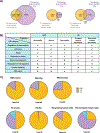Soft repression: Subtle transcriptional regulation with global impact
- PMID: 33215731
- PMCID: PMC9068271
- DOI: 10.1002/bies.202000231
Soft repression: Subtle transcriptional regulation with global impact
Abstract
Pleiotropically acting eukaryotic corepressors such as retinoblastoma and SIN3 have been found to physically interact with many widely expressed "housekeeping" genes. Evidence suggests that their roles at these loci are not to provide binary on/off switches, as is observed at many highly cell-type specific genes, but rather to serve as governors, directly modulating expression within certain bounds, while not shutting down gene expression. This sort of regulation is challenging to study, as the differential expression levels can be small. We hypothesize that depending on context, corepressors mediate "soft repression," attenuating expression in a less dramatic but physiologically appropriate manner. Emerging data indicate that such regulation is a pervasive characteristic of most eukaryotic systems, and may reflect the mechanistic differences between repressor action at promoter and enhancer locations. Soft repression may represent an essential component of the cybernetic systems underlying metabolic adaptations, enabling modest but critical adjustments on a continual basis.
Keywords: SIN3; gene regulation; metabolism; promoter; repression; retinoblastoma; transcription.
© 2020 The Authors. BioEssays published by Wiley Periodicals LLC.
Conflict of interest statement
CONFLICT OF INTEREST
The authors declare no conflict of interest
Figures



Comment in
-
Softly but surely: A new perspective on transcriptional repression.Bioessays. 2021 Feb;43(2):e2000326. doi: 10.1002/bies.202000326. Epub 2021 Jan 6. Bioessays. 2021. PMID: 33410192 No abstract available.
References
-
- Barolo S, & Posakony JW (2002). Three habits of highly effective signaling pathways: Principles of transcriptional control by developmental cell signaling. Genes Dev, 16, 1167. - PubMed
-
- Howe GA, Major IT, & Koo AJ (2018). Modularity in jasmonate signaling for multistress resilience. Annu. Rev. Plant Biol, 69, 387. - PubMed
Publication types
MeSH terms
Substances
Grants and funding
LinkOut - more resources
Full Text Sources

